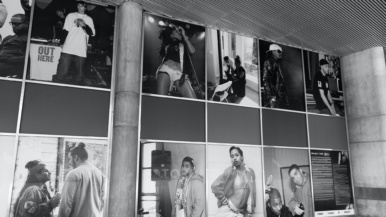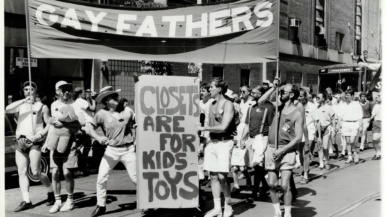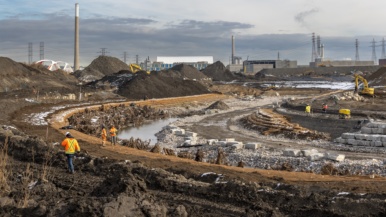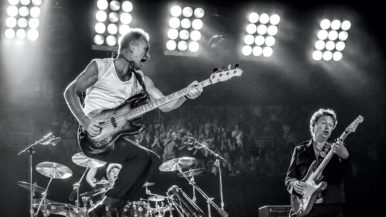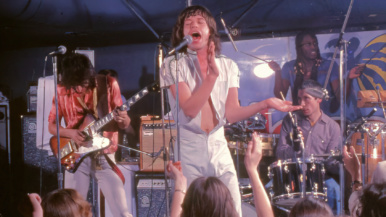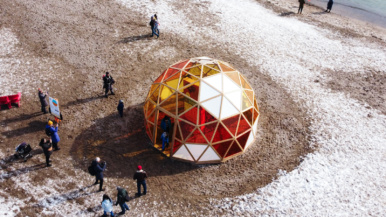Eleven amazing photographs that tell the gay history of Toronto

“Toronto is so much gayer than it thinks,” says Jane Farrow, one of more than 100 contributors and editors who contributed to the new anthology Any Other Way: How Toronto Got Queer. With excerpts from academics, activists, journalists, filmmakers and city councillors, Any Other Way provides a fascinating glimpse into the history of queer Toronto, including early cruising areas, bathhouse raids, and the city’s arts and music scene. Here, a look at some of the book’s most memorable photos.

Allan Gardens
Circa 1910
Allan Gardens was an early hot spot for both gay cruising (the trees provided cover for hooking up) and for surveillance (that’s a policeman pictured next to the central fountain). Its reputation dates back to 1882, when Oscar Wilde visited the park to deliver a lecture on his tour of North America. During his stay, he also watched a lacrosse match and ended up giving the media a revealing sound byte: “…That was the first opportunity I ever had of witnessing your national game, and I enjoyed it so much—but can you tell me who that tall, finely built man that played defence for the Torontos is?”

Hanlan’s Point Beach
circa mid-1950s
The Toronto’s Island beaches have been popular destinations for the gay community since the 1950s, around the time this photo of late activist Philip McLeod (in stripes) and his friends was taken. Thick shrubbery made the beach, like Allan Gardens, an ideal cruising spot, and also attracted the authorities. Occasionally, police monitored the beach from their boat or would walk through and make arrests.

“King Edward Hotel Declares War on Letros Queers”
December 2, 1961
In the early 1960s, major papers like the Toronto Star and the Globe And Mail wouldn’t touch the subject of homosexuality, with the exception of publishing articles that had to do with hysteria about the queer community. This headline appeared in Tab, one of many tabloid newspapers that published sensationalized stories during the 1950s and ’60s. The story was about the staff at the King Edward Hotel trying to keep patrons of Letros Tavern, a gay bar across the street, from frequenting the hotel’s washrooms. Any Other Way speculates that the story, while anti-queer on the surface, actually helped gay men discover where (and where not) to go to meet other men.

Jackie Shane
circa early 1960s
Transgender R&B singer Jackie Shane, seen here performing at Ascot Hall, encouraged Toronto to embrace its queerness. During the 1960s, she regularly performed in drag in Toronto. Her 1962 hit song, “Any Other Way,” is the inspiration for the name of the anthology. In the opening lyrics, “Tell her that I’m happy, tell her that I’m gay,” Shane’s use of the word “gay” was thought to be a subtle nod to the queer scene, as it wasn’t yet being used in a sexual context in mainstream vernacular.

First Gay Pride March
1972
In 1969, homosexuality had been decriminalized in Canada. And in 1971, Canada’s first gay liberation newsmagazine, The Body Politic, began publishing. But there was still much to march against in 1972—for instance, homosexuality was still considered legal grounds for rejecting immigrants. Attendance has since skyrocketed, and a whack of corporate advertisers have seized the opportunity to attach their brands to the powerful movement. When Farrow looks at this photo, she sees a Pride that was more accessible. There was nothing physically separating the marchers from those on the sidewalks, so anyone could get swept up in the emotion and join in, she says. “It was like this rolling gay caterpillar that queered everything in its wake.”

Cabbagetown Softball League
1975
The Cabbagetown Group Softball League was “founded” in 1975. LGBT teams made it possible for queers to reclaim public space, and their rise within the city gave Toronto a reputation as a hub of queer sports, especially as local teams formed relationships with gay leagues across North America. Toronto has since hosted several queer sporting events, including the 2000 Gay Softball World Series.

The Battle of Church Street
June 20, 1981
On February 5, 1981, police raided a number of Toronto bathhouses, places of sanctuary for gay men, and arrested hundreds of people, many of whom hadn’t yet come out to family or friends. That June, more raids took place, sparking demonstrations like the one captured in this photo. “People were so brave,” says Farrow. “They went face-to-face with not just homophobia and misogyny, but violence.” In June 2016, Toronto police chief Mark Saunders publicly apologized to the LGBT community for the raids.

Shirley with tattoo
1983
As a young teen in 1975, photographer Pam Gawn became enchanted with the disco and drag scene in the Yonge and Wellesley neighbourhood. Nearly a decade later, she went back to the area to photograph some of her old friends. Farrow says Gawn’s photos represent one of the last eras in which queers were all still in one place, living together, sharing groceries, and, “learning how to love.” Pictured here is one of Gawn’s old friends, Shirley. “Pam was once part of this scene,” says Farrow. “So she’s on the inside saying, ‘This isn’t a freak show. These are the people in my neighbourhood. They’re strong, fierce and proud of who they are.’”

Sisters of Perpetual Indulgence
1984
The Sisters of Perpetual Indulgence, pictured here outside Bathurst Street Theatre in 1984, are a charity, protest and performance organization that uses drag and religious imagery to call attention to sexual intolerance. The Bathurst Street Theatre is the former home of the Metropolitan Community Church of Toronto (MCCT), a large Protestant church with a predominantly LGBT congregation, now located in Riverdale.

KillJoy’s Kastle
2013
KillJoy’s Kastle, the infamous lesbian haunted house of 2013, was a week-long performance installation by artists Allyson Mitchell and Deirdre Logue. “A vagina dentata ushers you into a full-throttle feminist hell-house,” Farrow writes of the warehouse space at College and Lansdowne. Its goal was to challenge stereotypes and fears about lesbian feminists—namely, that they’re all butch ball-busters.
